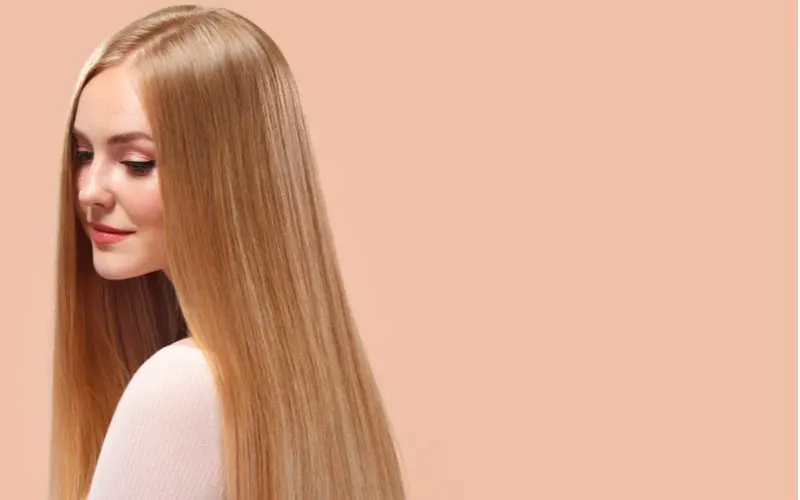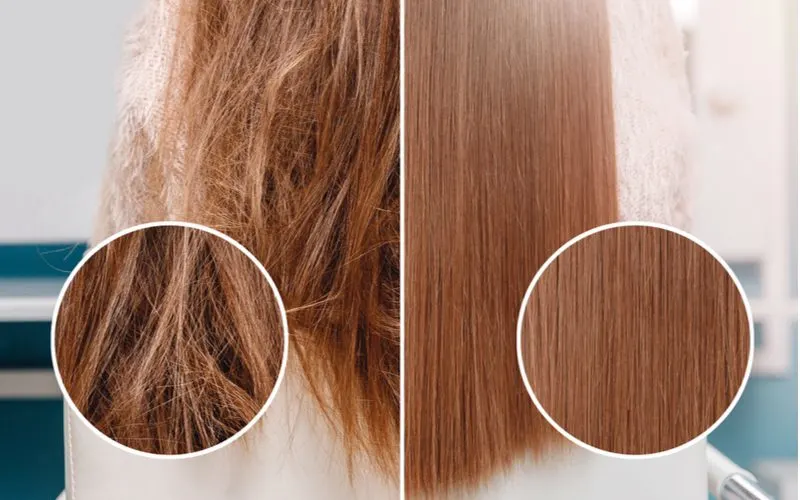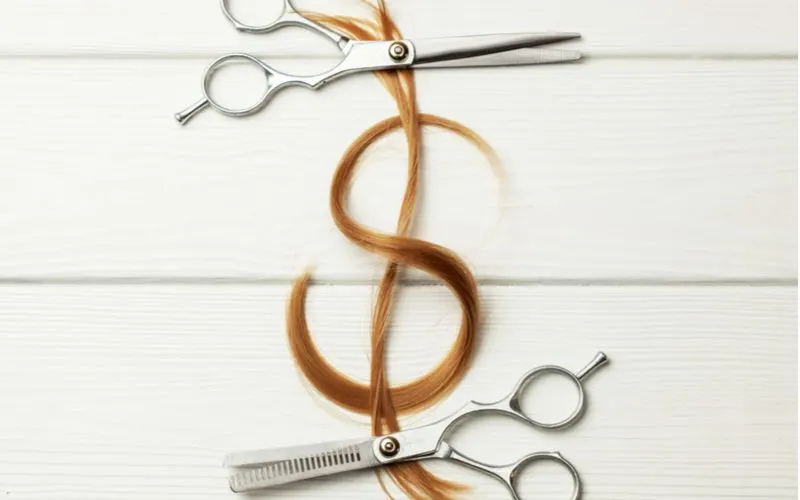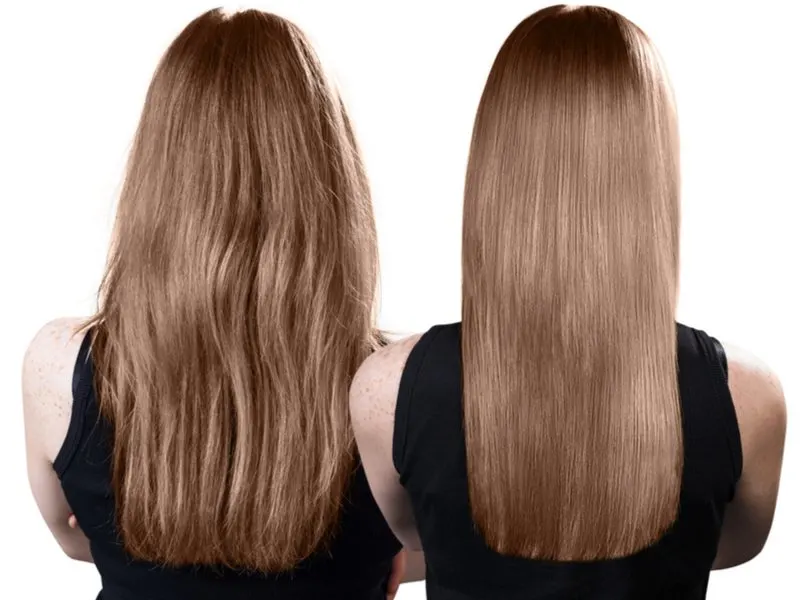Jump to:
A keratin treatment could be your ticket to stronger, shinier, smoother hair – if you have the right hair type for it. Read on to learn what they do, benefits and drawbacks, why some salons won’t do them, and more.
Considering a Keratin Treatment?
Whether you know it as a Brazilian blowout, straightening treatment, or keratin treatment, they all refer to the same thing: A semi-permanent chemical straightening treatment that smoothes the hair for sleek, flat-iron finish. These chemical treatments can actually straighten natural waves and curls and leave strands frizz-free and silky smooth for 3-6 months.
You can expect stronger, healthier-feeling hair with a glossy shine after one of these treatments.
Being able to let your hair air-dry to a perfectly straight, sleek finish sans frizz? That’s the stuff of dreams. Some women who’ve had these protein-based straightening treatments done say the effects are “life-changing.” But before you start thinking a Brazilian blowout is the hair care miracle we’ve all been waiting for, there are a few things to note.
We’ll cover all you need to know about these semi-permanent straightening treatments in this guide, including what the treatments involve, how they work, pros and cons, and when to avoid them. Let’s get started!
What Is a Keratin Treatment?

YuliyaOchkan/Shutterstock
Keratin treatments are semi-permanent straightening treatments that remove existing waves and curls, give the hair a glossy shine, and eliminate frizz for a sleek, flat-iron finish. Typically, these treatments are used on naturally frizz-prone, wavy, or curly hair.
They make it possible to achieve flat-ironed results without any additional heat, chemicals, or hair tools after the initial treatment. Keratin straightening treatments offer women a way to reduce styling time because the hair will air-dry to a perfectly straight, shiny finish.
These treatments last anywhere from 3 months to 6 months, so once you get it done, your locks are good to go for a while. But the treatments don’t offer permanently straight results. Your natural texture, including waves or curls, will come back once the treatment weakens.
Read Next: How to Straighten Hair Without Heat
How Keratin Treatments Work
It’s helpful to have an inside peek at the process so you’ll know what to expect if you decide to get it done. Here’s the typical keratin protein treatment process – and be warned, it takes a long time from start to finish. Bring a book!
- The hair is shampooed 1-2 times with a keratin (protein) based formula and rinsed.
- Next, the hair is thoroughly blow-dried so the treatment can be applied.
- The hair is sectioned off into 4-5 large sections. Then, the stylist will take smaller .5” to 1” sections and brush the treatment on, then comb through to evenly distribute it.
- A plastic cap is applied to trap heat and help the solution penetrate strands. It sits on the hair for 20 minutes (typical) to 30 minutes (for resistant hair). It is NOT rinsed out.
- The hair is again thoroughly blow-dried with the treatment still in it.
- A flat iron heated to anywhere from 380 degrees (for damaged, bleached, or fine hair) to 450 degrees (for coarse or resistant hair) is used to make 7-12 passes over small sections of the hair to set the treatment and create lasting straight texture.
Once the treated hair has been exposed to high heat – up to 450 degrees Fahrenheit – the straight texture and smoothness are “locked in.” But after it’s all said and done, you’re still not quite finished.
For the first three days (72 hours) after your treatment, you won’t be able to wash or style your hair. That means no curling, no ponytails, no headbands, and no clips. You can’t even tuck it behind your ears. Any of these will result in bends or dents in the hair that will be semi-permanent.
It’s not as bad as it sounds because your hair will look gorgeously sleek and straight after the treatment anyway, with no real need to style it. You also can’t wash it right away or get it wet. If your hair gets even slightly wet during this time, it could reverse the treatment and result in wavy or curly sections in your hair.
Tip: If your hair accidentally gets wet during the first 72 hours, just dry it quickly and flat iron the affected section so it’s straight again. The heat from your flat iron will cause the treatment to go back into effect and ensure all your hair has that sleek, straight texture!
Keratin Treatment Pros and Cons
There are definitely pros and cons associated with these powerful protein treatments. We like to look at all sides so you can make the most informed decision on whether or not one of these treatments will work for you. Here are the benefits and disadvantages of getting a semi-permanent straightening treatment or Brazilian blowout.
Pros (What We Like)

Parilov/Shutterstock
There’s a reason (okay, several reasons) why women are obsessed with Brazilian blowouts and semi-permanent straightening treatments. They work, the results are gorgeous, and you get to enjoy the benefits for months. You’ll also notice improved hair texture and manageability once you get the treatment.
Smooth, Frizz-Free Results
The keratin in these treatment formulas smoothes the outermost layer of hair cells (also made of keratin) to make them less prone to frizz and smoother overall. It works similarly to patching a pothole in the street – the keratin in the treatment fills in gaps in the outer layer of hair strands and gives them a smooth, more even texture.
Fuses Split Ends
Keratin won’t technically fix or “heal” split ends, but it does work to fuse them together, so they’re not as obvious. When you get a keratin-based treatment, any split ends you have will be bonded together with keratin so they look healthy and whole while the treatment lasts.
Shinier, Stronger Hair
The smoothness that keratin creates along each hair strand has another great effect on your hair – it makes it radiantly shiny. Because each strand is smooth down to the microscopic level without gaps or uneven areas, it’s better at reflecting light. That means more shine without the need for special serums or oil-based sprays.
Keratin-treated hair is also stronger. Since keratin is the main component of hair, fortifying every strand with it makes it even stronger and more resistant to breakage.
No Styling Required
If you opt to get one of these treatments, it’s likely because you want pin-straight locks that don’t require labor-intensive styling each morning. That is one of the main benefits of these treatments.
You’ll wake up with silky, straight hair even if you tossed and turned all night. It’ll air dry to sleek perfection without the need for additional products or tools. There’s no real need to style it beyond making a couple passes with a flat iron while you’ve got the treatment.
Cuts Drying Time in Half
Keratin-based treatments will cut your usual drying time in half. If you hate spending time blow drying before heat styling, we can’t think of a better solution than one of these protein-infused treatments.
If drying usually takes you 30 minutes, it’ll be closer to 15 minutes after the treatment. And if you’d rather skip blow-drying altogether, keratin-treated hair doesn’t take long to air dry, either.
Less Daily Damage
Another benefit women get from doing a keratin-infused treatment is reduced daily damage from heat and styling. Reduced shampooing (which helps prolong the treatment) also reduces the amount of damage you expose your hair to.
Thanks to the treatment, when you wake up with great hair, there’s no need to heat a flat iron or curling iron to style it in the mornings. And without the intensive brushing, combing, pinning, braiding, or sectioning involved with styling your hair, it will be exposed to much less damage daily while the treatment is still active.
Cons (What We Don’t Like)

ADragan/Shutterstock
These protein-infused treatments are not perfect, and they won’t work for everyone. Make sure you know what you’re getting into by reading about the cons and disadvantages of getting one of these treatments.
May Contain Toxic Chemicals and Carcinogens
Keratin straightening treatments work because they use a damage-inducing combo of harsh chemicals and intense heat. Formaldehyde is one of those harsh chemicals, and many women understandably aren’t comfortable using a treatment that contains a known carcinogen like this.
You’ll see that most keratin-type treatments are labeled as “formaldehyde-free.” That’s just a marketing ploy because ALL keratin-based treatments are technically formaldehyde-free. None of the formulas actually contain this dangerous chemical.
Instead, they contain formaldehyde derivatives or raw ingredients such as methylene glycol, formalin, methanal, and methanediol. When water is mixed with these chemicals in the treatment, or when high heat is applied, it releases formaldehyde gas – a known carcinogen and toxic gas.
If you’d rather skip the formaldehyde risk altogether, ignore “formaldehyde-free” claims for keratin-based treatments and opt instead for a glyoxylic acid-based keratin treatment. These safer treatments still have a smoothing effect on the hair and don’t release formaldehyde when heated.
Won’t Work on All Hair Types
These treatments aren’t for everyone. While they’re awesome for straightening and smoothing frizz-prone wavy or curly hair, they’re not very effective on super-curly ringlets or coily textures.
Curly to coily textures may not get perfectly straight results from these treatments. You may be left with considerable waves, curls, or frizz. And if your hair is baby-fine or already damaged, one of these chemical treatments could leave your hair in worse shape than ever.
Time-Consuming Process
Keratin-infused straightening treatments take a long time to do. Expect to be in the chair for anywhere from 2 hours to 4 hours, depending on your hair length and your stylist’s preferred process.
You start with an initial shampoo (possibly 2) to clean and clarify the hair. Then, it’s blow-dried fully, the treatment itself is applied to tiny sections, and then your hair has to be blow-dried thoroughly again.
After that, your stylist will need to run a flat iron over very small sections of your hair many times – sometimes doing 10-12 passes over each section to ensure it’s perfectly straight. At the end, you’ll have spent somewhere between 90 minutes and 4 hours getting the treatment done. And you have to wait three days to wash, style, or even tuck your hair behind your ears.
Results Are Not Permanent
Japanese straightening treatments and relaxers give you permanent results, but keratin-based treatments do not.
You’ll be able to enjoy the straight, frizz-free results for up to 6 months if you follow proper maintenance steps, but it won’t last much longer than that. If you wash your hair more than 2-3 times a week, your treatment might last as little as three months.
The Treatments Are Expensive
If you thought your balayage appointment was costly, you might want to take note that keratin treatments are even more expensive. Expect to pay somewhere between $250 and $500 for your treatment, depending on the salon you visit, the brand of treatment used, your hair length, and more.
Also, consider that these semi-permanent treatments only last 3-6 months, so it’s an expense you’ll have to keep paying to continue enjoying those sleek results.
Keratin Straightening Treatment Maintenance

Roman Samborskyi/Shutterstock
Now that we’ve gone over the pros and cons, let’s talk about the proper way to maintain your treatment to get the longest-lasting results. Your straight, frizz-free results can last anywhere from 3-6 months, but you’ll get closer to the six-month end if you follow these maintenance tips.
- Don’t touch it for three days afterward. Okay, you can touch it. But don’t do any of the following for at least 72 hours after your treatment. No tucking it behind your ears, clipping/pinning it, heat styling, ponytails, etc. Don’t even put your sunglasses on top of your head! The slightest bend or dent in your hair during the first 72 hours will be permanent.
- Use sulfate-free shampoo. Sulfates in shampoo strip your hair of natural oils that keep it moisturized, soft, and healthy. Using a sulfate-free shampoo is less harsh on treated hair and helps maintain your results longer.
- Shampoo less often. Even with a good sulfate-free shampoo, you still don’t want to overdo it by washing too often. If your hair can handle it, try washing just 2 or 3 times a week to prolong your results. Use a dry shampoo to soak up excess oil in between washes.
- Apply leave-in conditioner before swimming. If you plan to take a dip after getting a protein treatment, apply a leave-in conditioner first. It will protect your strands from harsh chlorine, which eats away at keratin and diminishes your results.
If you follow these tips, you’ll get the maximum results out of your treatment.
Who Should Use Keratin Treatments?

VGstockstudio/Shutterstock
We mentioned that these treatments aren’t for everyone, but who do they work best for? See which types of hair will get the best results from a protein treatment below.
Healthy to Slightly Damaged Hair
Healthy hair is obviously the best candidate for any chemical treatment like this, but surprisingly, slightly damaged hair is also a great candidate for a protein treatment.
Women with some hair damage will likely see the most dramatic results from a treatment like this. That’s because the protein smoothing makes a bigger difference on damaged hair, while healthy hair may not look all that different afterward.
Wavy Hair (Type 2)
Wavy hair is considered type 2 hair. It ranges from very slight bends in the hair (type 2A) to borderline curls (type 2C). This hair type does really well with keratin straightening treatments.
Since there isn’t much bend in the hair to begin with, it’s easy for a protein-based formula to perfectly straighten and smooth wavy hair to a flat-iron finish.
Curly Hair (Type 3)
Curly hair is perfectly suited for these treatments. Since curl types tend to struggle with frizz and tangles, a smoothing and straightening treatment like this works wonders. But how straight your hair becomes has a lot to do with how curly it is to start with.
Larger curls (type 3A) and medium curls (type 3B) will get the best results from a keratin-based treatment. Tighter curls may not completely straighten out and give the sleek look you want.
Frizzy Hair
One of the main benefits these treatments offer is the elimination of most frizz. If you’ve been dreaming of smoother locks without frizz, you’re probably a great candidate for a keratin-infused treatment. You’ll notice smoother strands that don’t tangle as much with almost no frizz, even when you air dry.
High Porosity Hair
High hair porosity means your hair has many gaps in the outer cell layer, making it hard to hold onto water and nutrients. The outer cell layer is fortified by treating high porosity hair with protein, and those gaps are closed up. The result is more moisturized, better-nourished hair that feels smoother to the touch.
Should You Try a Keratin Treatment?

Kotin/Shutterstock
We’ve looked at a lot of information, so let’s take a step back and think about this. Should you actually get a keratin treatment?
You should definitely consider it if you have frizzy, high porosity, healthy, slightly damaged, wavy, or curly hair. Any of these hair types will achieve sleek, straight texture from one of these treatments. You’ll also experience a major reduction in frizz while boosting shine and strength.
But if you’re still feeling iffy about it, that’s okay. These treatments are expensive, only last 3-6 months, take hours to do, and limit what you can do with your hair for the three days following your treatment.
Not to mention the fact that some treatments contain ingredients that combine to make formaldehyde – a known carcinogen and toxic gas.
If you’re not quite sold on getting a keratin-infused treatment, you can still achieve frizz-free locks. Check out our guide, How to Get Rid of Frizzy Hair, next to learn how!
